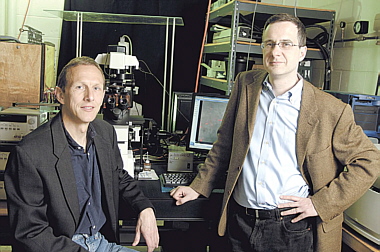
News Release
|
Office of News and Information Johns Hopkins University 901 South Bond Street, Suite 540 Baltimore, Maryland 21231 Phone: 443-287-9960 | Fax: 443-287-9920 |
May 15, 2006 FOR IMMEDIATE RELEASE CONTACT: Phil Sneiderman 443-287-9960 prs@jhu.edu |
Johns Hopkins Launches Institute to Apply
Emerging Science to Medical Problems
The Johns Hopkins University is preparing to aim enormous research and educational resources at some exceedingly small targets.
Drawing on the expertise of more than 75 faculty members from such diverse disciplines as engineering, biology, medicine and public health, the university today officially launched its ambitious new Institute for NanoBioTechnology.
The institute will strive for major advances in medicine by developing new diagnostic tools and treatments based on interdisciplinary research conducted at the atomic or molecular level. The institute will encourage the movement of these campus breakthroughs into the private sector for further development and marketing. At the same time, institute members will train the next generation of scientists and engineers in this emerging field, offering both graduate-level instruction and a new undergraduate minor in nanobiotechnology.
"Our goal is to establish Johns Hopkins as the world's top research center for nanobiotechnology," said Peter Searson, a professor of materials science and engineering who is director of the institute. "We plan to do this in a way that integrates research, education and technology transfer."
 |
| Heading up the institute for NanoBio Technology will be Peter Searson, Director, and Denis Wirtz, associate Director. |
The institute is being launched with $6 million in funding and the participation of dozens of Johns Hopkins faculty members from the Whiting School of Engineering, the School of Medicine, the Krieger School of Arts and Sciences, and the Bloomberg School of Public Health.
The institute will make use of existing laboratory space on the university s Homewood and medical campuses in Baltimore. Its startup funding has been provided by the National Science Foundation, the Howard Hughes Medical Institute, NASA and various Johns Hopkins divisions. Additional financial support is being sought.
Searson said he was particularly grateful to U.S. Sen. Barbara Mikulski, D-Md., who helped secure some of the startup funding and who has expressed strong support for the institute.
The institute s researchers will toil at the scientific frontier where nanotechnology, a field that is perhaps 15 years old, is applied to biology and medicine. This emerging research focus, nanobiotechnology, is barely a decade old. Johns Hopkins is the ideal setting for such a far-reaching effort, organizers say, because it is one of the few institutions in the world that can bring together world-class expertise in the many disciplines needed to study and test biological components smaller than a human cell and to fabricate materials and devices that can operate at this scale.
The scale is astonishingly small. A nanometer is one billionth of a meter. By comparison, a single strand of human hair is roughly 50,000 to 80,000 nanometers wide. Some of the projects envisioned by institute researchers involve manipulation of a single molecule or a fragment of protein.
Institute members will work within four key research areas:
 Diagnostics, including the development of
molecular imaging probes that can relay information about
the health of a patient's organs and other tissues without
the need for a biopsy. Advances in this area promise to
greatly enhance the way diseases are diagnosed and
treated.
Diagnostics, including the development of
molecular imaging probes that can relay information about
the health of a patient's organs and other tissues without
the need for a biopsy. Advances in this area promise to
greatly enhance the way diseases are diagnosed and
treated.
 Therapeutics, including nanoscale forms of
drug delivery, gene therapy, protein therapy and
immunotherapy. These will be used to treat diseases such
as cancer and asthma and conditions such as spinal cord
injuries.
Therapeutics, including nanoscale forms of
drug delivery, gene therapy, protein therapy and
immunotherapy. These will be used to treat diseases such
as cancer and asthma and conditions such as spinal cord
injuries.
 Cellular and molecular dynamics, including
the use of powerful new tools to study the inner working
of cells. This knowledge should help identify causes of
disease and new molecular targets that could help cure
medical disorders.
Cellular and molecular dynamics, including
the use of powerful new tools to study the inner working
of cells. This knowledge should help identify causes of
disease and new molecular targets that could help cure
medical disorders.
 Health and environment, a research thrust
that will use the new tools and techniques of
nanobiotechnology in understanding the potential impact of
nanotechnology on public health and the environment.
Health and environment, a research thrust
that will use the new tools and techniques of
nanobiotechnology in understanding the potential impact of
nanotechnology on public health and the environment.
The institute's organizers say its greatest strength will be its ability to tackle complex medical problems by drawing on an array of Johns Hopkins experts with widely different skills. For example, a new therapy for cystic fibrosis might begin with tiny polymer particles developed by chemistry experts, carrying medications developed by biologists. These researchers may collaborate with fluid mechanics experts to find the most effective way to get these particles into the lungs. Surface scientists, toxicologists and other medical experts would assist in getting these particles through the lungs' mucus barrier and into the appropriate cells without endangering the patient.
"We envision this institute providing research coordination, seed funding and lab facilities for projects like these," Searson said.
Color images of the institute s directors available; contact Phil Sneiderman.
Related Links
Institute for NanoBioTechnology Web Site
|
Johns Hopkins University news releases can be found on the
World Wide Web at
http://www.jhu.edu/news_info/news/ Information on automatic e-mail delivery of science and medical news releases is available at the same address.
|
 Go to
Headlines@HopkinsHome Page
Go to
Headlines@HopkinsHome Page